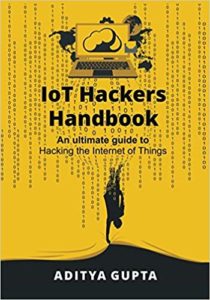IoT Hackers Handbook
 Somewhere, I don’t know where, I was getting aware of the book “IoT Hackers Handbook” from Aditya Gupta. Well, bought it, read it. That wasn’t quite a long job as the font size is a bit larger than normal. There are two reasons you do this, either you want to avoid that older reader need their glasses (me?) or there’s not too much content but you still want to make it look like a in-depth book on the topic.
Somewhere, I don’t know where, I was getting aware of the book “IoT Hackers Handbook” from Aditya Gupta. Well, bought it, read it. That wasn’t quite a long job as the font size is a bit larger than normal. There are two reasons you do this, either you want to avoid that older reader need their glasses (me?) or there’s not too much content but you still want to make it look like a in-depth book on the topic.
It was indeed a bit different than expected. Not bad, but different, which also tells you something. I’m a software guy, looking into hardware-near topics like BLE sniffing is interesting but not my homeland, so to say. But this book really started with hardware hacking after some introductory chapter on penetration testing IoT devices. I mean UART communication, JTAG debugging. Then it went slowly up in direction software, via firmware hacking, mobile apps (Android), software define radio (SDR) to Zigbee and BLE sniffing and packet resend. It didn’t get higher than this. That’s ok, as there had been topic, I hadn’t touched so far except for BLE sniffing. Especially the SDR part was quite interesting and encouraged my to maybe dig a bit into this topic. Understanding the communication of garage door openers etc. sounds interesting over all.
Don’t get me wrong, for consumer IoT devices, this is all important stuff to understand, test and hack. But IoT is a bit more than hardware, firmware and communication, at least in my mind. IoT lives from software, and not just hardware-near software. That is what brings the value and the new business models for IoT. Sure the book touched mobile apps as important part of a IoT solution but there is all the cloud connectivity and the software stack on the IoT device that I find the interesting part. And that was not covered beyond ZigBee and BLE. So not bad and helpful but surprising regarding the direction of what IoT pentesting should be like and maybe telling something about how IoT is regarded still today.
To be fair, the book did dig into some use-cases of what you could do when having access to the device and being able to manipulate it at will, which wasn’t really difficult with the examples provided by the author. Weather stations, door openers, garage openers, the usual smart light bulb and beacons. I learned still a lot about tools and techniques for these low-end IoT devices and how easy it is to break them with just a little bit of knowing some tools and reading specifications. And unfortunately you can transfer this experience to more complex “IoT” devices like PLCs in IIoT or gateways. Just the specifications are a bit thicker and complex. But the door is equally wide open for white as well as black hats.